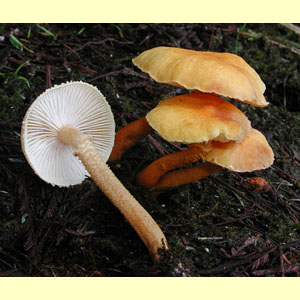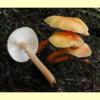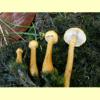
images/Cystoderma/Cystoderma_KRT2957.jpg
Small to medium agaric, growing among bryophytes or rarely on soil, with a white to pale cream spore print. Pileus yellow or brown, rarely white, dry, granular. Lamellae adnexed, adnate or sinuate or notched. Stipe central, granular below. Partial veil remnants a membranous annulus. Spores hyaline, amyloid, smooth; germ pore absent. Cheilocystidia absent. Lamellar trama regular or interwoven. Pileipellis an epithelium. Clamp connections present.
Among white-spored agarics with an annulus, the amyloid spores separate
Cystoderma from
Armillaria (which grows on wood, not among moss) and
Lepiota (where the pileus is typically squamulose rather than granular).
Amanita can have amyloid spores and a powdery pileus, but there is typically a volva at the stipe base. Another genus with white lamellae and spore-print and a roughened, yellow pileus is
Cyptotrama, but this lacks an annulus when mature and grows on wood.
Cystoderma Fayod, Ann. Sci. Nat., Bot., sér. 7, 9: 350 (1889).
One or few species (all with amyloid spores):
Cystoderma muscicola (based on an Australian type specimen), and with some reports in Australian literature of
C. amianthinum (which has a Northern Hemisphere type specimen). The distinction between these two species needs investigation.
Species of Cystoderma with non-amyloid spores belong to section Granulosae, which has been recognised at generic rank as Cystodermella. The only records from Australia of this group are of C. granulosum, but these are doubtful.
S.A., Qld, N.S.W., Vic. and Tas. (and probably also W.A.).
In native forests, including alpine areas.
Always among moss, on the ground.
Saprotrophic.
Breitenbach, J. & Kränzlin, F. (eds) (1995),
Fungi of Switzerland.
Volume 4. Agarics 2nd part. Edition Mykologia, Lucerne. [
Illustration,
Description and
Microcharacters of
C. amianthinum]
Fuhrer, B. (2005), A Field Guide to Australian Fungi. Bloomings Books, Hawthorn. [Description and Illustration of C. amianthinum]
Fuhrer, B. & Robinson, R. (1992), Rainforest Fungi of Tasmania and South-east Australia. CSIRO Press, East Melbourne. [Illustration of C. aff. amianthinum]
Grgurinovic, C.A. (1997a), Larger Fungi of South Australia. The Botanic Gardens of Adelaide and State Herbarium and The Flora and Fauna of South Australia Handbooks Committee, Adelaide. [Description, Illustration and Microcharacters of C. muscicola]
McCann, I.R. (2003), Australian Fungi Illustrated. Macdown Productions, Vermont. [Illustration of C. amianthinum]
Phillips, R. (1981), Mushrooms and other Fungi of Great Britain and Europe. Pan Books, London. [Illustration of the non-Australian species C. amianthinum from the United Kingdom, which is similar in appearance to C. muscicola]
Wood, A.E. (2003), Some agarics of the Kosciuszko National Park, Australas. Mycol. 22: 39–43. [Description and Microcharacters of C. amianthinum]





